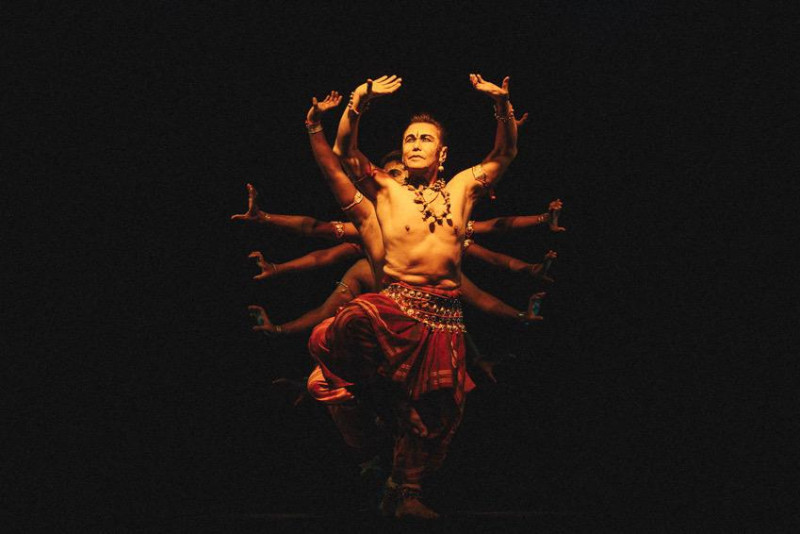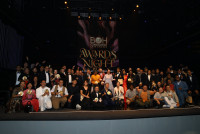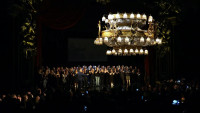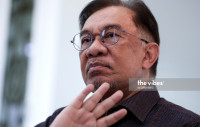AS the theatre lights dimmed, a powerful mantra comes on filling the hall and breaking the audience’s mild chatter into silence.
A ceremonious glow draws the attention of watchful eyes towards the stage, with it appeared three dancers, all moving melodiously to the Maha Mrityunjaya and the thunderous beats of the sabdas that followed.
Gripping in the beginning already, and perfect as I was about to witness the art of Odissi, albeit more contemporary, on stage.
The intro pays homage to the triple-eyed Lord Siva, said to be the nourisher of the spiritual essence, and liberator of soul from the bondage of opposites.
When someone mentions a dance recital, ballet immediately comes to mind but imagine the intrigued I felt as the invitation to watch a Datuk Ramli Ibrahim production presents itself. Seeing him perform on stage for the first time sets a lot of high expectations.
Triple Frontiers, a celebration of three women dance-makers of Odissi features works of three gurus; Sujata Mishra, Parwatti Dutta and Meera Das. Designed in a triple-bill format, the production premieres a fresh and creative interpretation performed by artists of Sutra Foundation.

Having interviewed its artistic director, imagine the eagerness one felt after being told that the work may not be recognised by the dance-makers themselves.
How is that celebrating the gurus?
“By keeping the vocabulary intact,” remembering Ramli’s assertion a few days prior.
The audience is then greeted by the Dance of Krishna where the dancers begin to become more animated with their striking fluidity of the group’s composition.
You could tell that the troupe had worked hard in preparing themselves prior to the showcase that every portrayal of their movements accompanied by the expressions managed to captivate the eye once it locks itself, from dancer to dancer. Not one face is forgettable.
Never mind the fall that one of the dancers experienced, which was barely noticeable. I only realised it as it happened directly within my scope of view where I was seated. In fact, I am quite puzzled and not sure if it was intentional all along now that I am writing this out, recollecting the whole act.
The story for the dance drama goes – the gopis were bewitched by the deity (in the form his bejewelled apparition, beguiling smile and movements). With the imagined backdrop of the Yamuna river, they embraced him as he danced to capture the hearts of his audience underneath the ‘moon-lit’ night.
This was a work referenced off Guru Sujata Mishra teachings, contemporaries in a group presentation and a touch of Sutra (depicted through the formation of the curves and sudden theatrics without overwhelming the space) as opposed to a solo. It is a setup applied to the acts that would come next.
The second episode of the triple-bill is my favourite.
I guess it is the ease of understanding the story that is portrayed without referring to the program book to mark where I am moving accordingly with the act.
Beyond that, what was poignant about the performance is that it was able to tap into my curiosity and lustful nature to explore and understand culture.
Surya, the Sun, was explained to be the source of Life, representing the age-old notion of battling darkness over light, as the piece introduced itself.
On stage we see the dancers separated into different groups to interpret the melodic moods that chimed into our ears. Again, I was engrossed by the movements of the dancers – distinct to the individual even when represented as a collective.
Guru Parwati Dutta who is the sharer of the movements said in the program book, “the journey with evaluative, contemplative, intuitive and artistic exploration and mystical poetic passages continue to nourish my Odissi consciousness, and I am happy to share these gems with the dedicated dancers of Sutra.”
Now I will not go ahead and point out whether the troupe had successfully hit their poses or uphold the techniques correctly since I have zero-to-none training in classical Indian dance. However, what is assuring to know is that even the most amateur of patrons can grasp the story being told. Here it was both on the Suryashtakam and the Vadya Pallavi.
The final episode was the celebration of Guru Meera Das and her teachings.
_with_dancers_of_Sutra_Dance_Outreach_Program1.jpg)
We were given a background of the Mita Chaha ee Para, referred from medieval Odia poem, which tells the audience of Krishna as the supreme lover and the focus of admiration by the gopis.
The art and literature depicting his beauty is narrated time and time again, and that night at the MBPJ civic hall, it was retold again.
A touching way to send the audience off with a piece that not just portrays the graceful elegance of the story, expressed through the dance formations and efficient footwork.
The complexities of the dance were made vivid as the music composition builds itself to reach the climax of the show. By this time, you could tell that the dancers are giving all their ‘semangat’ as their breathing is more apparent through their stomach – still without breaking out of their characters.
As I have come to realise, the percussion of Odissi has a variety of syllables, and with each I understand why the production goes out of their way to showcase these variations even if it is just short-off a two-hour showcase (minus the VVIP speeches and token presentations, which could be done post performance since it really cuts off the build-up of excitement).
I appreciated the lyrical aspect that Triple Frontiers was trying to uphold embodying religion/spiritualism, philosophy, and mythology through dance art.
Suffice to say the otherworldly beauty and whimsical experience gifted through the invite, opened a path for me into appreciating traditional forms our country is rich with and to work hard to be the advocate of better. – The Vibes, April 11, 2021





.jpg)
.jpg)















